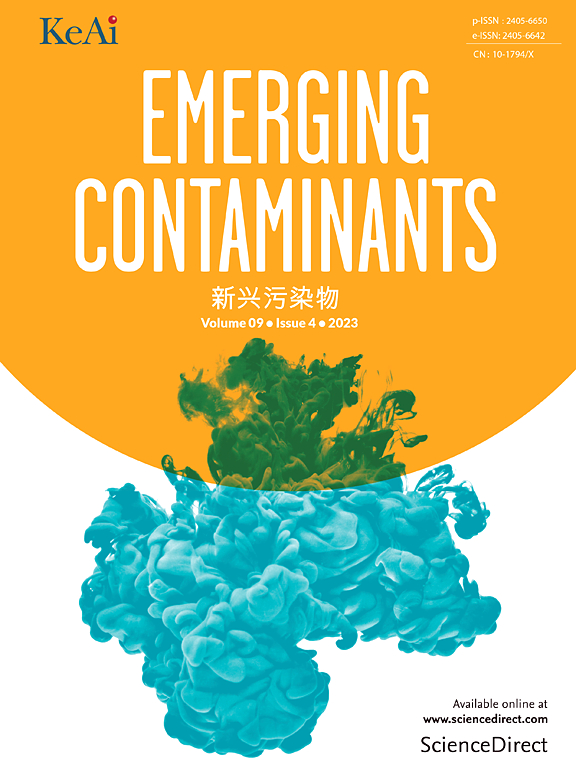聚四氟乙烯(PTFE)微塑料影响鸭胚的血管生成和中枢神经系统(CNS)发育
IF 5.3
2区 环境科学与生态学
Q1 ENVIRONMENTAL SCIENCES
引用次数: 0
摘要
众所周知,长期接触致畸剂会导致神经管缺陷(NTDs),这是一种严重的中枢神经系统(CNS)畸形,是造成全球婴儿死亡的重要原因。近年来,接触纳米塑料(NPs)与神经嵴闭合缺陷和神经发育改变有关,因为它们会改变细胞粘附分子和塑料微粒在神经管中的积聚,从而导致 NTD。然而,有关各类微塑料(MPs)对中枢神经系统畸形影响的研究仍然有限。在这项研究中,我们以鸭子为模型生物,研究了聚四氟乙烯(PTFE)--一种常用于烹饪用具不粘涂层的塑料--的MPs是否会影响血管生成和中枢神经系统发育。在鸭胚胎发育的第 3 天施用不同浓度的 PTFE MPs(0.01 毫克/毫升、0.1 毫克/毫升、1 毫克/毫升和 5 毫克/毫升),并使用绒毛膜(CAM)检测法评估血管生成情况。第 8 天和第 18 天分别对脊柱和大脑的大体形态和组织学进行了分析。傅立叶变换红外光谱(FTIR)证实了 PTFE 的结构,而扫描电子显微镜(SEM)和 DLS 分析则显示颗粒大小在 300 纳米和 5 微米之间,将其归类为 MPs。高浓度(5 毫克/毫升)的聚四氟乙烯微粒处理鸭胚后,死亡率下降了 35%,血管密度降低,这表明其具有抗血管生成的作用。在经 PTFE 处理的胚胎中观察到大脑和脊柱异常,如脑畸形和脊髓断裂。根据这些结果,PTFE 是一种影响鸭胚胎发育的抗血管生成剂和致畸剂。本文章由计算机程序翻译,如有差异,请以英文原文为准。
Polytetrafluoroethylene (PTFE) microplastics affect angiogenesis and central nervous system (CNS) development of duck embryo
Prolonged exposure to teratogens is known to cause neural tube defects (NTDs), a severe malformation of the central nervous system (CNS) that significantly contributes to global infant mortality. In recent years, exposure to nanoplastics (NPs) has been linked to faulty neural crest closure and altered neurulation by altering cellular adhesion molecules and accumulation of plastic particles in the neural tube leading to NTDs. However, research on the influence of various types of microplastics (MPs) on malformations of the CNS are still limited. In this study, we investigated whether MPs of polytetrafluoroethylene (PTFE)—a type of plastic commonly used as non-stick coatings of cooking utensils can affect angiogenesis and CNS development using ducks as model organisms. PTFE MPs were administered on Day 3 of duck embryo development at varying concentrations (0.01 mg/ml, 0.1 mg/ml, 1 mg/ml, and 5 mg/ml), and angiogenesis was evaluated using a chorioallantoic membrane (CAM) assay. Gross morphology and histology of the spinal column and brain were analyzed on Days 8 and 18, respectively. FTIR confirmed PTFE's structure, while SEM and DLS analyses showed particle sizes between 300 nm and 5 μm, classifying them as MPs. High concentrations (5 mg/ml) of PTFE MPs treated on duck embryos resulted in a 35 % mortality rate and reduced vascular density, suggesting anti-angiogenic effects. Brain and spinal abnormalities, such as encephalomalacia and spinal cord discontinuities were observed in the PTFE-treated embryos. Based on these results, PTFE is an anti-angiogenic and teratogenic agent affecting the development of duck embryos.
求助全文
通过发布文献求助,成功后即可免费获取论文全文。
去求助
来源期刊

Emerging Contaminants
Medicine-Public Health, Environmental and Occupational Health
CiteScore
10.00
自引率
6.70%
发文量
35
审稿时长
44 days
期刊介绍:
Emerging Contaminants is an outlet for world-leading research addressing problems associated with environmental contamination caused by emerging contaminants and their solutions. Emerging contaminants are defined as chemicals that are not currently (or have been only recently) regulated and about which there exist concerns regarding their impact on human or ecological health. Examples of emerging contaminants include disinfection by-products, pharmaceutical and personal care products, persistent organic chemicals, and mercury etc. as well as their degradation products. We encourage papers addressing science that facilitates greater understanding of the nature, extent, and impacts of the presence of emerging contaminants in the environment; technology that exploits original principles to reduce and control their environmental presence; as well as the development, implementation and efficacy of national and international policies to protect human health and the environment from emerging contaminants.
 求助内容:
求助内容: 应助结果提醒方式:
应助结果提醒方式:


